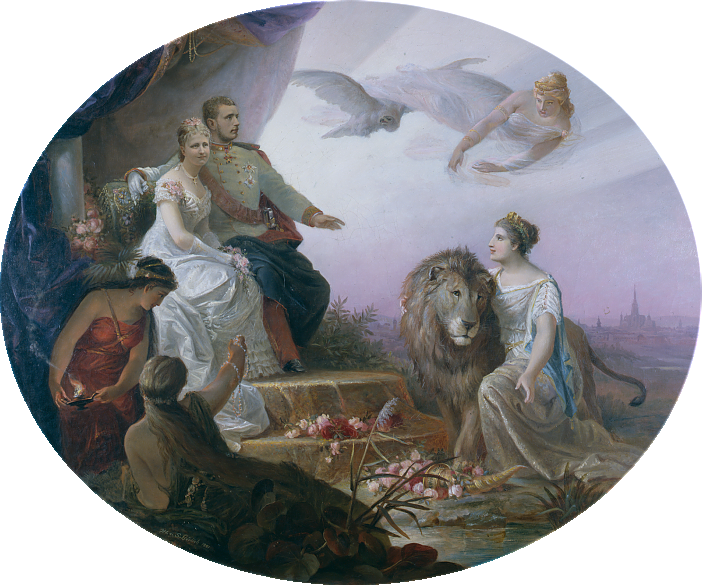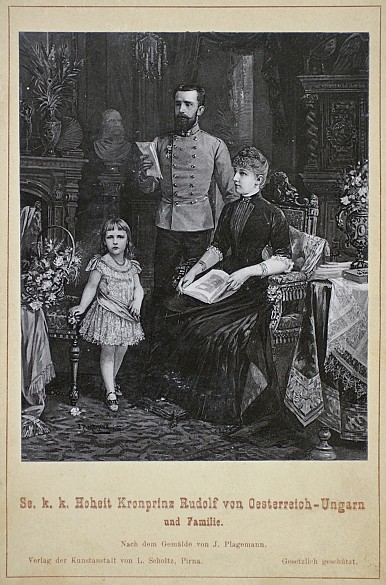An unhappy union: Rudolf and Stephanie
The marriage of Crown Prince Rudolf and Stephanie, who was from the royal house of Belgium, was a typical dynastic union, concluded for reasons of state rather than from personal liking.
From Rudolf’s farewell letter to his wife, quoted from Hamann, Brigitte: Rudolf. Kronprinz und Rebell, Munich 2004 (10th unabridged paperback edition), p. 458Dear Stephanie, You are freed from my presence and vexation; be happy in your fashion. Be good to the poor little one, who is the only thing that remains of me.
Stephanie’s father, King Leopold II of Belgium, was from the German noble lineage of Saxe-Coburg-Gotha, which acquired significant influence during the nineteenth century through a series of shrewd marital alliances. The royal dynasty had been founded by Stephanie’s grandfather, Leopold I, when he was offered the Belgian crown in 1831.
The bride’s father, Leopold II, was one of the richest men of his time – Franz Joseph referred disparagingly to the Belgian monarch, who was extremely successful in his commercial enterprises, as a ‘grocer’. It was during his reign that Belgium attempted to establish itself as a colonial power in Africa. Belgium’s ‘land-grab’ in the region of the Congo in central Africa, which was achieved by brute force and with shocking atrocities, was highly controversial even at the time.
In 1853 Leopold II married Archduchess Maria Henriette, daughter of Archduke Josef Anton, the founder of the Hungarian Habsburg line. Stephanie was thus half Habsburg on her mother’s side.
The wedding took place in 1881. Stephanie, who was born on 21 May 1864, was not even seventeen and still little more than a child. The young crown princess was very tall and not deemed to be especially pretty, and her personality is described as rather unattractive. She found difficulty in being accepted by her husband’s family – her mother-in-law Elisabeth famously referred to her as an ‘ugly bumpkin’.
Nevertheless, the first few years of marriage seem to have been harmonious. In 1883 Stephanie bore a daughter called Elisabeth (known as Erzsi in the family), who was to remain the couple’s only child as her parents became estranged over the following years. With his liberal views and unconventional (and occasionally inconsiderate) lifestyle, Rudolf had become an outsider at the Viennese court and found increasingly little in common with Stephanie, who was very conservative and haughty in her manner. When Rudolf infected his wife with a venereal disease he had picked up from one of his numerous extra-marital escapades and which subsequently made her infertile, the relationship reached its nadir. It seemed that the possibility of a separation could no longer be excluded.
Rudolf’s suicide at Mayerling in 1889 ended an unhappy marriage, but also undermined Stephanie’s position at the Viennese court. The crown princess was made indirectly responsible for his act of desperation, since she was deemed to have failed to provide him with the necessary emotional security. Isolated in the family and rejected by court society, she avoided the court, travelling extensively. Stephanie’s difficult character also led to problems with her Belgian family, with whom she fought several legal battles concerning property and inheritance.
In 1900 Stephanie finally remarried. Her husband was the Hungarian aristocrat Count Elemér Lónyay de Nagylónya (1863–1946). She left the imperial family, waiving her right to her title and all associated privileges. Emperor Franz Joseph became the legal guardian of her daughter Elisabeth.
In 1935 she caused a sensation with the publication of her scandalous memoirs, which even led to court proceedings with her daughter.
Stephanie died in 1945 in the Benedictine Abbey of Pannonhalma in Western Hungary, where she had fled before the advancing Russian army and where she is also buried.














